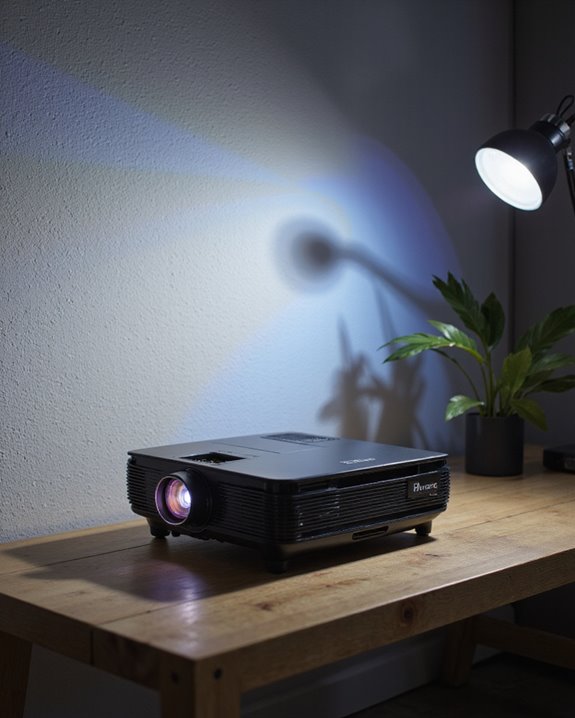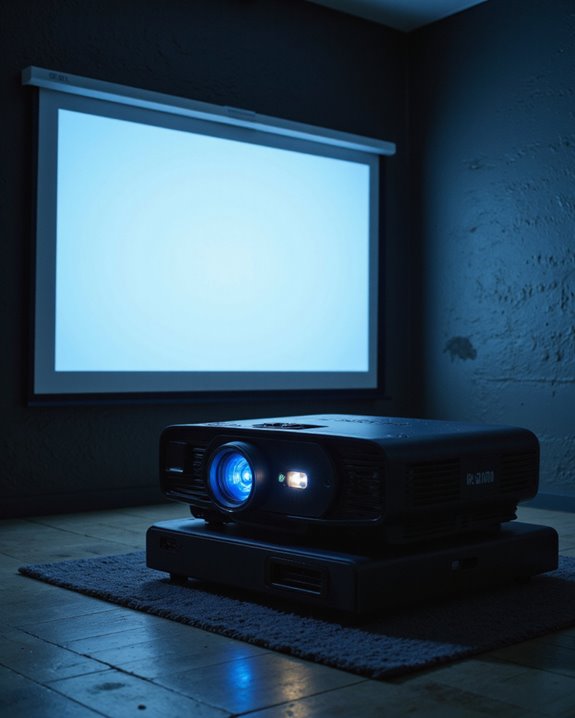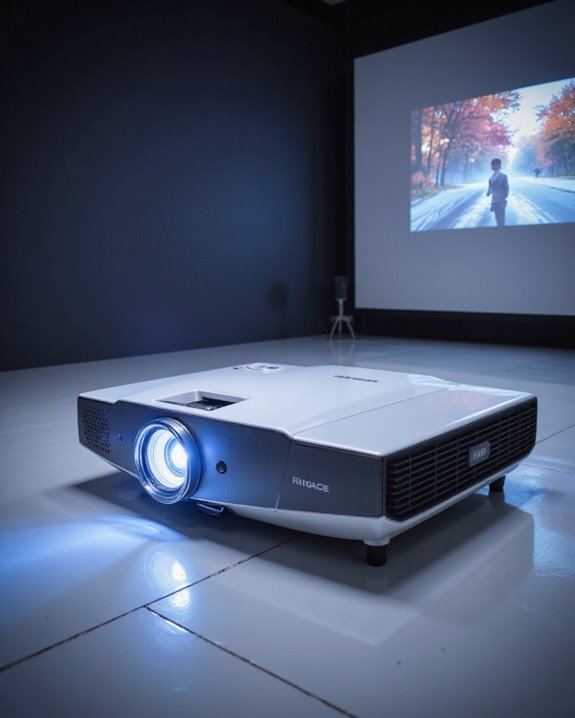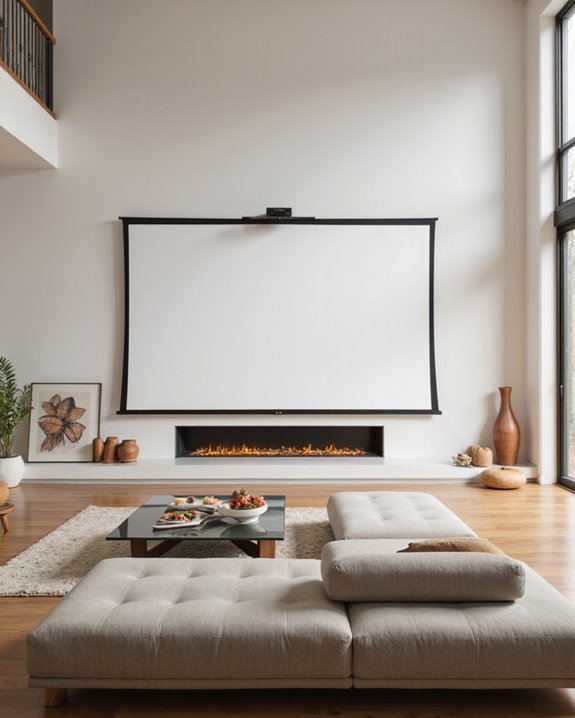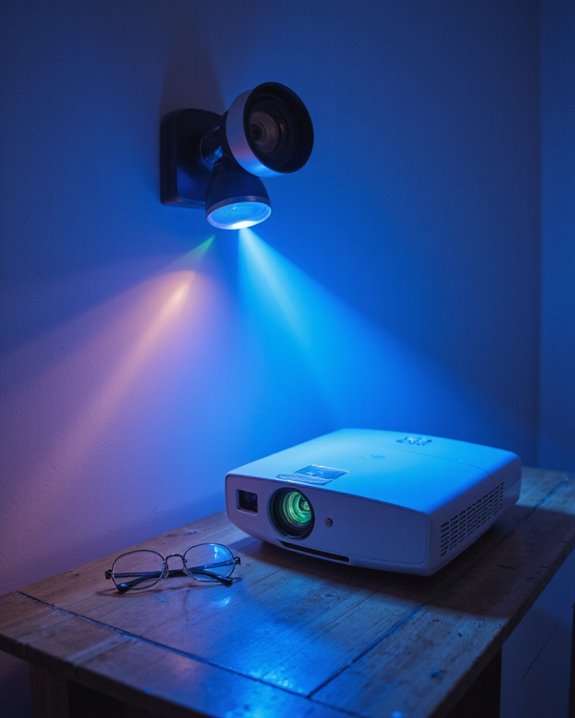Modern projectors can be effectively positioned at various angles through built-in features like keystone correction and lens shift technology. For ideal image quality, vertical angles should stay under 5 degrees to prevent distortion. Advanced projectors include automatic screen fit and angle compensation features, ensuring clear images even in challenging positions. Proper mounting hardware and cable management are essential for safety and stability. The latest projection technologies continue to expand creative installation possibilities beyond traditional setups.
Key Takeaways
- Yes, projectors can be positioned at angles, but it’s recommended to keep vertical angles under 5° to prevent image distortion.
- Modern projectors include features like keystone correction and lens shift to compensate for angled positioning and maintain image quality.
- Angled projection enables creative applications like projection mapping and allows installations in spaces with mounting constraints.
- Screen material choice and proper mounting hardware are crucial for successful angled projector installations.
- Automated features like Screen Fit and angle compensation help optimize image quality when projectors must be mounted at angles.
Understanding Angled Projection Basics
When setting up a projector, understanding the basic principles of angled projection proves essential for achieving ideal image quality. The positioning of a projector at different angles significantly impacts screen alignment and potential projection distortion, making proper placement crucial for optimal viewing experiences. The vertical angle between the projector and screen should typically remain under 5 degrees to minimize image warping and maintain clarity. Screen material selection also plays a vital role, as different surfaces respond uniquely to various angles of projection. Matte white surfaces offer the most flexibility for different projection angles while maintaining consistent image quality. The throwing angle, which determines how far the image travels before reaching the screen, must be carefully calculated to achieve the desired image size without compromising quality. Proper lens alignment helps prevent tilted or stretched images, while features like keystone correction can help compensate for necessary angular adjustments. Additionally, understanding projection geometry can assist in optimizing projector placement and image accuracy.
Technical Features That Support Angled Positioning
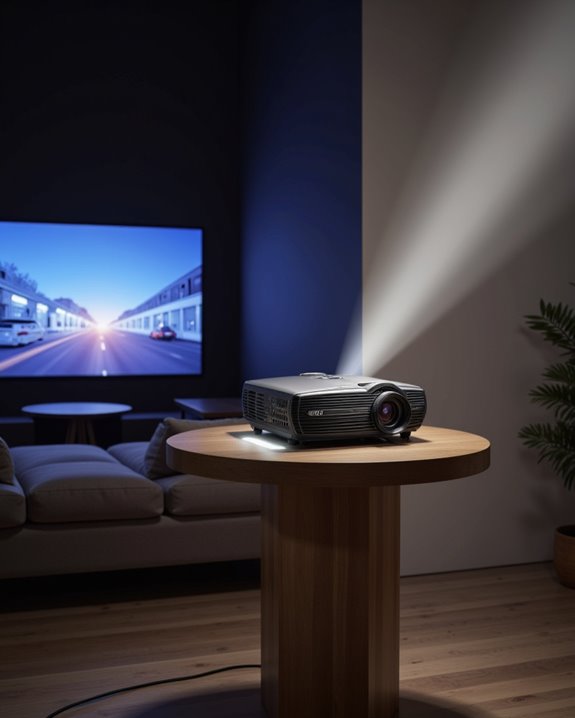
Modern projectors incorporate several technical features that enable effective angled positioning and image correction. Two key features stand out: lens shift and keystone correction. Lens shift allows the projector to move the image vertically and horizontally without physically relocating the device, while keystone correction fixes the trapezoidal distortion that occurs when projecting at angles.
These features work together to maintain image quality in various mounting positions. Lens shift can extend up to three times the screen height for high ceiling installations, and keystone correction can be either manual or automatic. Many projectors also include advanced capabilities like corner correction for non-flat surfaces and curved surface projection options. The convenient Screen Fit feature automatically detects and adjusts the image size and position. Additionally, some models support angle compensation to optimize image quality when the projector is mounted at an extreme angle. These technical innovations make it possible to achieve clear, rectangular images even when the projector isn’t perfectly aligned with the screen.
Benefits of Positioning Your Projector at an Angle
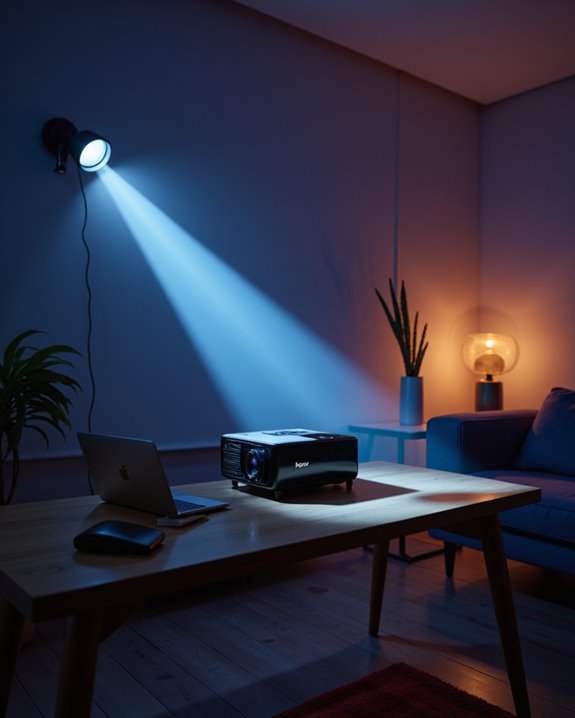
Positioning a projector at an angle offers numerous practical advantages that extend beyond traditional straight-on projection setups. The flexibility allows users to overcome space limitations while minimizing projection distortions through proper adjustment. Various mounting options enable projection onto curved surfaces, irregular walls, or multiple screens simultaneously. Angle adjustment technology in modern projectors ensures image stability and clarity even when positioned off-center. This angled setup delivers significant operational benefits, including improved viewing angles for larger audiences and enhanced space utilization in rooms with obstacles like ceiling fans or light fixtures. Modern laser projectors maintain stable luminance levels even when positioned at angles, ensuring consistent image quality over extended periods. The arrangement also contributes to better safety and reduced clutter by keeping cables and equipment out of high-traffic areas. Additionally, angled positioning supports creative applications in architectural designs, enabling projection mapping onto building facades or creating immersive environments through unconventional surface projections. The versatility in placement makes it particularly valuable for both permanent installations and temporary setups.
Essential Installation Tips for Angled Projectors
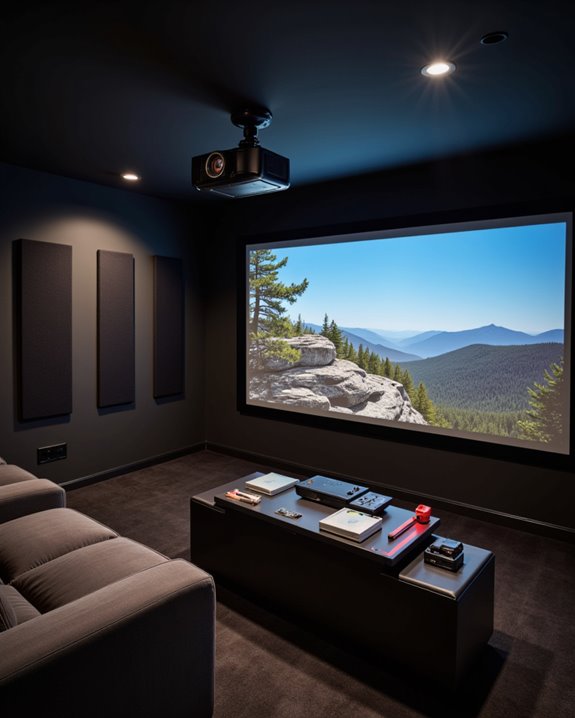
Successful installation of angled projectors requires careful attention to several critical factors that determine image quality and system stability. Safety precautions begin with selecting appropriate mounting hardware that can support the projector’s weight, while guaranteeing secure attachment to ceiling studs or reliable anchors. Proper alignment focuses on maintaining the projector lens within 5 degrees of the screen’s center to minimize distortion. Understanding that a 50/50 throw angle requires significantly higher mounting positions is crucial for achieving optimal image placement.
Essential maintenance tips include organizing cables with adequate slack for future adjustments and using protective raceways when surface mounting is necessary. Installers should calculate throw distances and angles precisely before mounting, utilizing adjustable brackets for fine-tuning the position. Regular checks of mounting hardware and cable connections help prevent stability issues, while keeping the lens clean ensures ideal image quality throughout the projector’s operational life.
Common Challenges and Solutions in Angled Projection
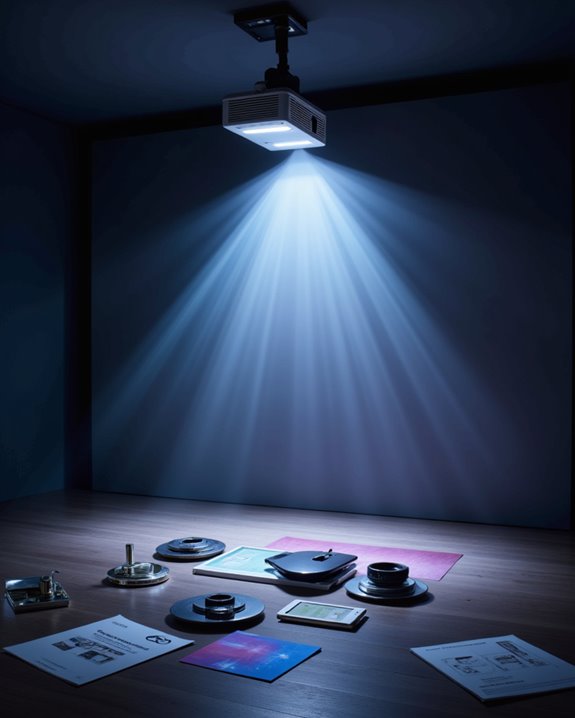
The installation of angled projectors presents several technical hurdles that require specific solutions for ideal performance. Key challenges include image distortion, reduced brightness, and alignment difficulties that can affect the overall viewing experience. Color calibration becomes particularly essential when projecting at an angle, as the skewed positioning can alter how colors appear on the screen. Images often appear stretched and uneven when projected onto angled surfaces without proper adjustments.
Common issues also extend to power compatibility and mounting stability. To address these challenges, installers can implement several solutions:
- Using keystone correction to adjust image shape
- Applying lens shift technology for better positioning
- Selecting appropriate screen materials that handle angular projection well
- Installing professional mounting brackets for secure placement
- Employing projection mapping software for complex setups
Regular maintenance and proper setup ensure maximum performance despite the angular positioning.
Creative Applications and Advanced Techniques
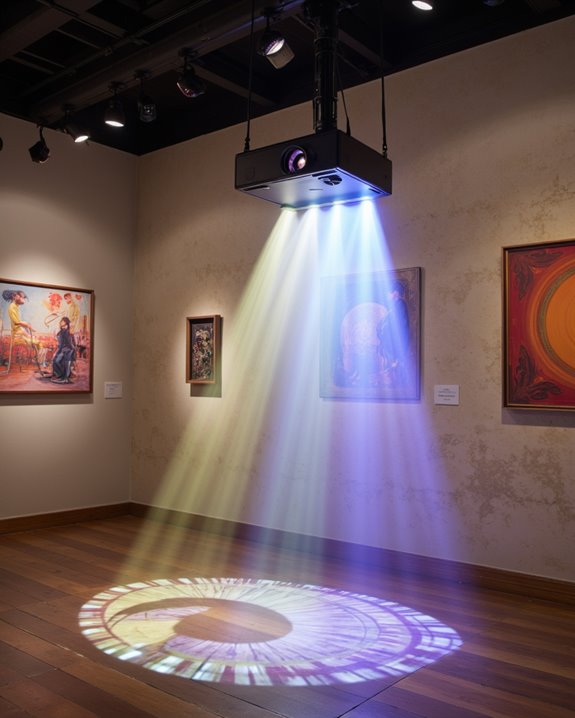
Modern angled projection techniques extend far beyond basic display capabilities, opening new possibilities for creative expression and technical innovation. Advanced systems combine multiple projectors with specialized software to create seamless displays on various surface textures, from rough concrete to smooth glass. Color calibration ensures ideal image quality across different materials and lighting conditions. Proper lens shift adjustments allow precise image positioning without compromising quality.
Creative applications include:
- Interactive art installations that respond to viewer movement
- Architectural displays that transform building facades
- Exhibition designs that create immersive environments
- Educational presentations that enhance learning through spatial engagement
- Theatrical productions with dynamic visual effects
These applications rely on projection mapping software and automated alignment systems to maintain precise image placement. The technology continues to evolve with improvements in resolution, brightness, and integration with other digital media platforms.
Frequently Asked Questions
Can Angled Projection Affect the Lifespan of My Projector’s Lamp?
Research indicates that angle impact has no direct effect on lamp lifespan. The durability of projector lamps depends primarily on usage hours, maintenance practices, environmental conditions, and the type of lamp technology used.
What’s the Maximum Safe Temperature for a Projector Installed at an Angle?
The maximum safe temperature remains 104°F (40°C), but angled installations may require lower operating temperatures due to ventilation concerns. Proper heat dissipation becomes more critical when projectors are mounted at unconventional angles.
Does Angled Projection Work Equally Well With All Types of Projection Screens?
Different projection surfaces respond differently to angled projection. Screen materials like CLR and lenticular screens may perform poorly at extreme angles, while standard matte screens generally maintain consistent performance regardless of projection angle.
How Often Should I Recalibrate My Projector When Using Angled Positioning?
Like a well-tuned instrument, projectors require monthly recalibration when angled. Check mounting stability and cable management bi-weekly, with additional adjustments needed if environmental changes occur or image quality deteriorates between scheduled maintenance.
Will Using Angled Projection Void My Projector’s Manufacturer Warranty?
Manufacturers typically don’t void warranties solely for angled positioning. However, installation concerns should align with specified guidelines. Warranty implications arise only if improper angling causes damage or compromises the projector’s operational functionality.

